The Ivy League is a group of eight private universities with rich histories widely considered to be some of the best in the country for their long-held standards of academic excellence.
These schools differ from state schools and universities. Whereas a state school is small and offers only undergraduate associate’s or bachelor’s degrees, a university often provides graduate programs and supports a larger student population.
We’ve looked at all eight Ivy League schools and found comparable alternative institutions.
For a school to be considered an Ivy League alternative, it must:
- Have a cost of attendance less than the highest Ivy League cost of attendance ($222,252)
- Have a post-graduate income greater than the lowest Ivy League post-graduate income ($78,943)
We’ve ranked schools individually according to their costs of attendance, post-grad incomes, and return on investment rates. To make comparison easier, we’ve placed non-Ivy schools with top variables into a visual table format alongside their Ivy League counterparts. In terms of ROI, these institutions take their place alongside Ivy League contenders.
What is return on investment (ROI), and how can it help me?
Return on investment, or ROI, refers to the difference between what you spend on school and your income after graduation. It is a school’s average post-graduation income divided by its total cost of attendance. If you’re wondering whether an Ivy League–or any other type of schooling–is worth the cost, these percentages will be influential.
Cost of Attendance
According to the National Center for Education Statistics, it takes approximately 6 years for over half of all undergraduate students to complete a 4-year program. When configuring the total cost of attendance, we calculated the annual cost multiplied by that average of 6 years.
Post-graduate Income
Post-grad income refers to the median earnings of financial aid students 10 years after graduating. This figure provides a measure of future payoff compared to immediate cost.
Ivy League Alternatives
#1 Princeton University
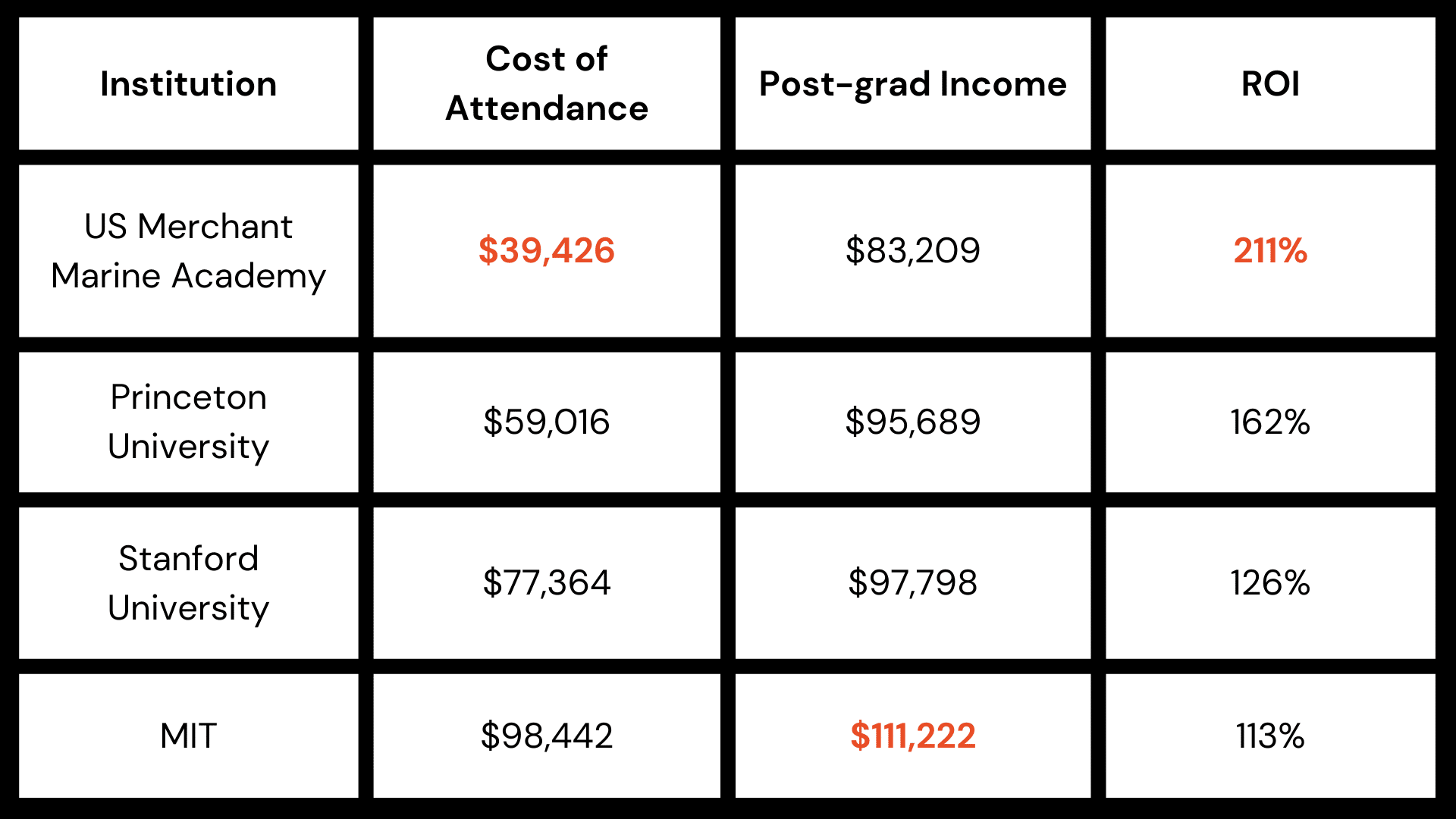
Princeton University Alternatives
- Princeton University programs
- US Merchant Marine Academy programs
- Stanford University programs
- Massachusetts Institute of Technology (MIT) programs
With an ROI of 162%, Princeton University takes spot #1 among Ivy League schools. This institution offers programs like applied and computational mathematics, comparative literature, and language and culture. Only three non-Ivy schools compare to Princeton in terms of ROI: the US Merchant Marine Academy, Stanford University, and the Massachusetts Institute of Technology (MIT).
Because of their high return on investment scores, Stanford and MIT are mentioned multiple times within this ranking and are worth noting as the best Ivy League alternatives. As a specialized institution with limited program offerings, the US Merchant Marine Academy is not comparable to every Ivy League. However, because of its high return on investment and low cost of attendance, it merits a spot at the top of our ranking.
Cost of Attendance
- US Merchant Marine Academy – $39,426
- Princeton University – $59,016
- Stanford University – $77,364
- MIT – $98,442
Post-grad Income
- MIT – $111,222
- Stanford University – $97,798
- Princeton University – $95,689
- US Merchant Marine Academy – $83,209
ROI
- US Merchant Marine Academy – 211%
- Princeton University – 162%
- Stanford University – 126%
- MIT – 113%
#2 Harvard University
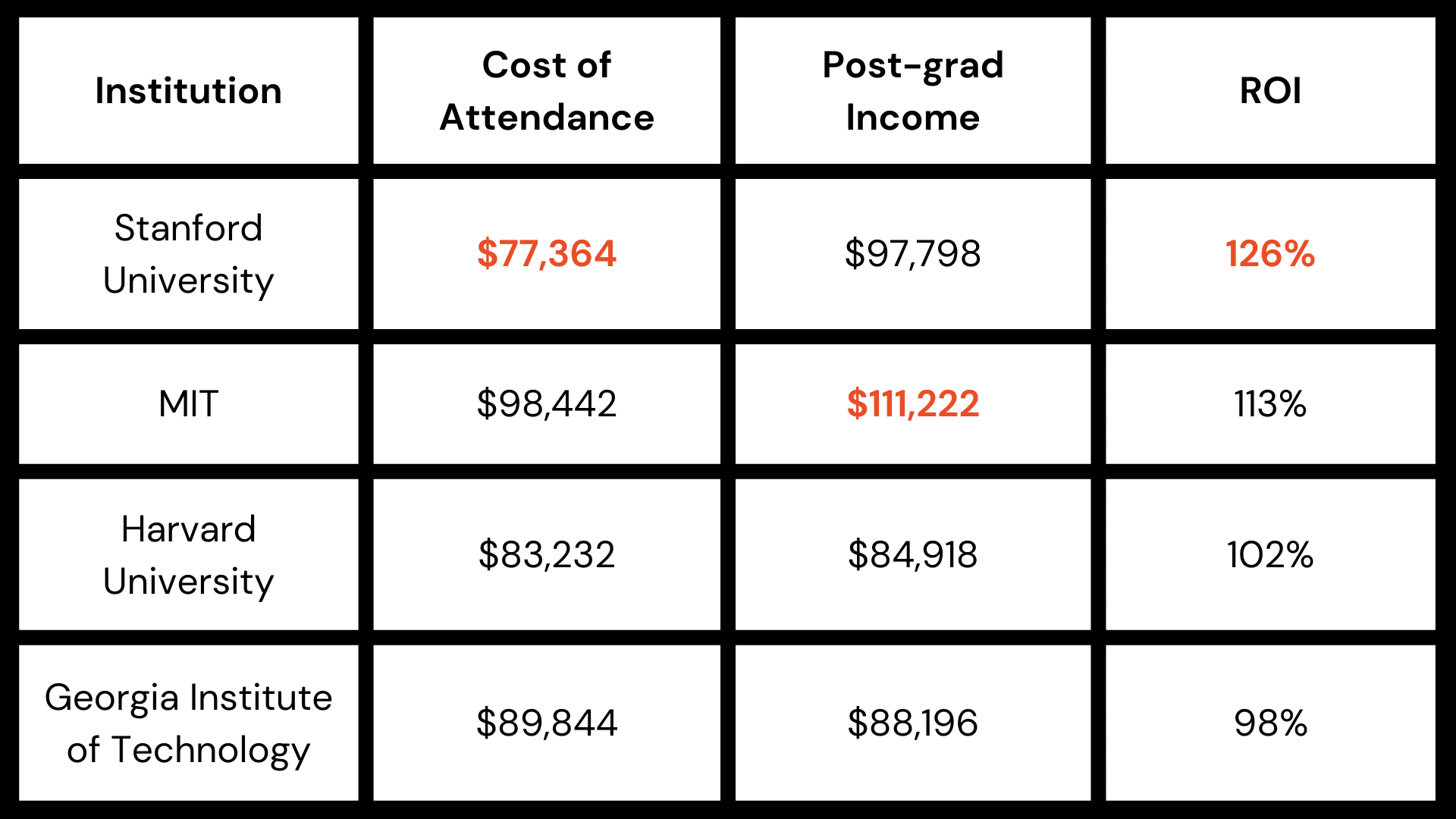
Harvard University Alternatives
- Harvard University programs
- Stanford University programs
- MIT programs
- Georgia Institute of Technology programs
Harvard University was founded in 1636, it offers undergraduate, graduate, and doctoral degrees in biomedical engineering, economics, linguistics, and more. Regarding cost-vs-return, Harvard has a ratio of 102%, placing third for both ROI and post-grad income next to MIT and Stanford. Its other alternative, the Georgia Institute of Technology, scores an ROI of 98%.
Cost of Attendance
- Stanford University – $77,364
- Harvard University – $83,232
- Georgia Institute of Technology – $89,844
- MIT – $98,442
Post-grad Income
- MIT – $111,222
- Stanford University – $97,798
- Georgia Institute of Technology – $88,196
- Harvard University – $84,918
ROI
- Stanford University – 126%
- MIT – 112%
- Harvard University – 102%
- Georgia Institute of Technology – 98%
#3 Yale University
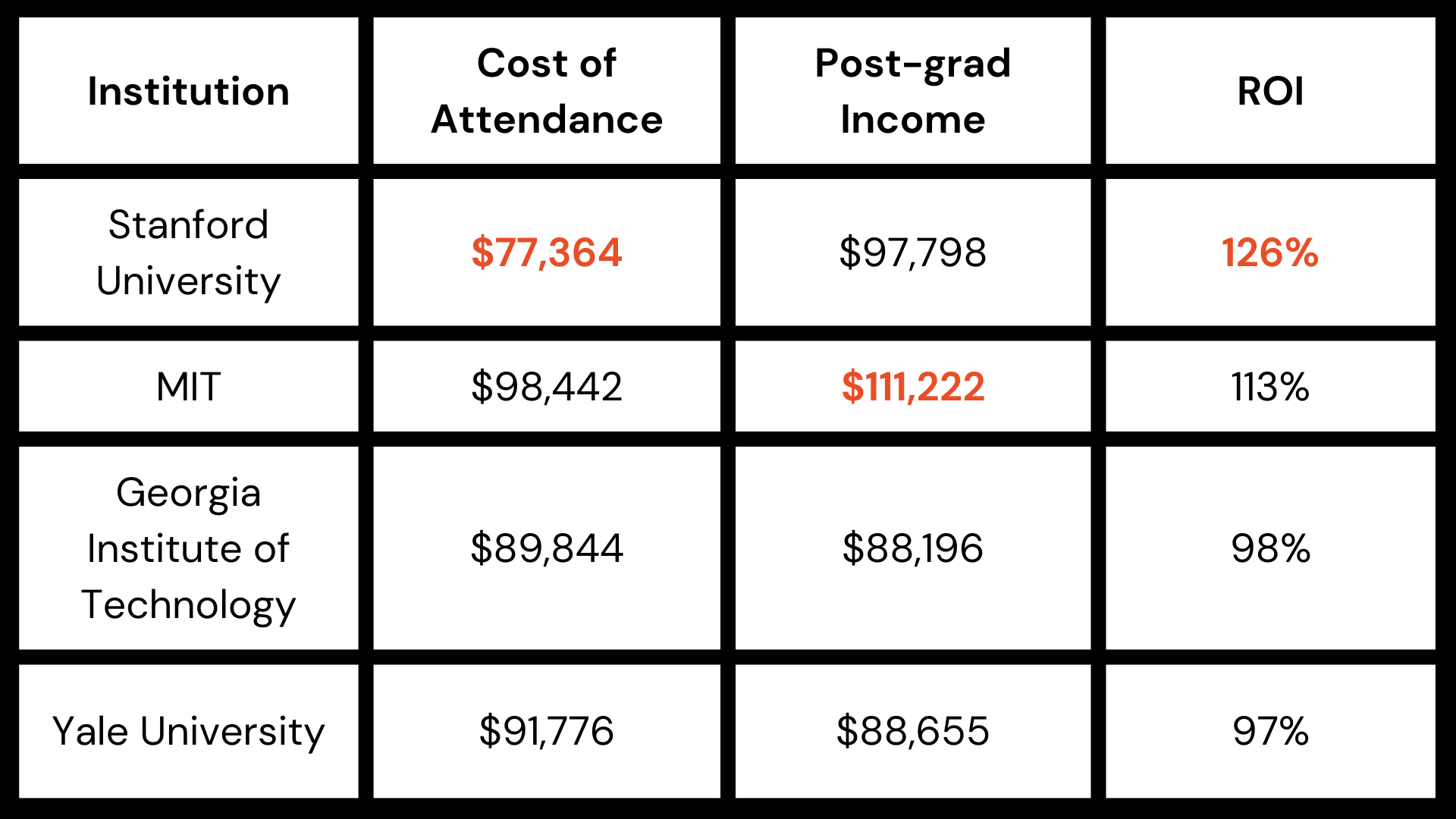
Yale University Alternatives
- Yale University programs
- Stanford University programs
- MIT programs
- Georgia Institute of Technology programs
Since its founding in the 1640s, Yale University has offered undergraduate and graduate programs in fields like ecology and evolutionary biology, modern middle east studies, engineering, music, and more. Its ROI percentage is 97%, and its comparable non-Ivy options include Stanford University, MIT, and the Georgia Institute of Technology.
Cost of Attendance
- Stanford University – $77,364
- Georgia Institute of Technology – $89,844
- Yale University – $91,776
- MIT – $98,442
Post-grad Income
- MIT – $111,222
- Stanford University – $97,798
- Yale University – $88,655
- Georgia Institute of Technology – $88,196
ROI
- Stanford University – 126%
- MIT – 113%
- Georgia Institute of Technology – 98%
- Yale University – 97%
#4 University of Pennsylvania
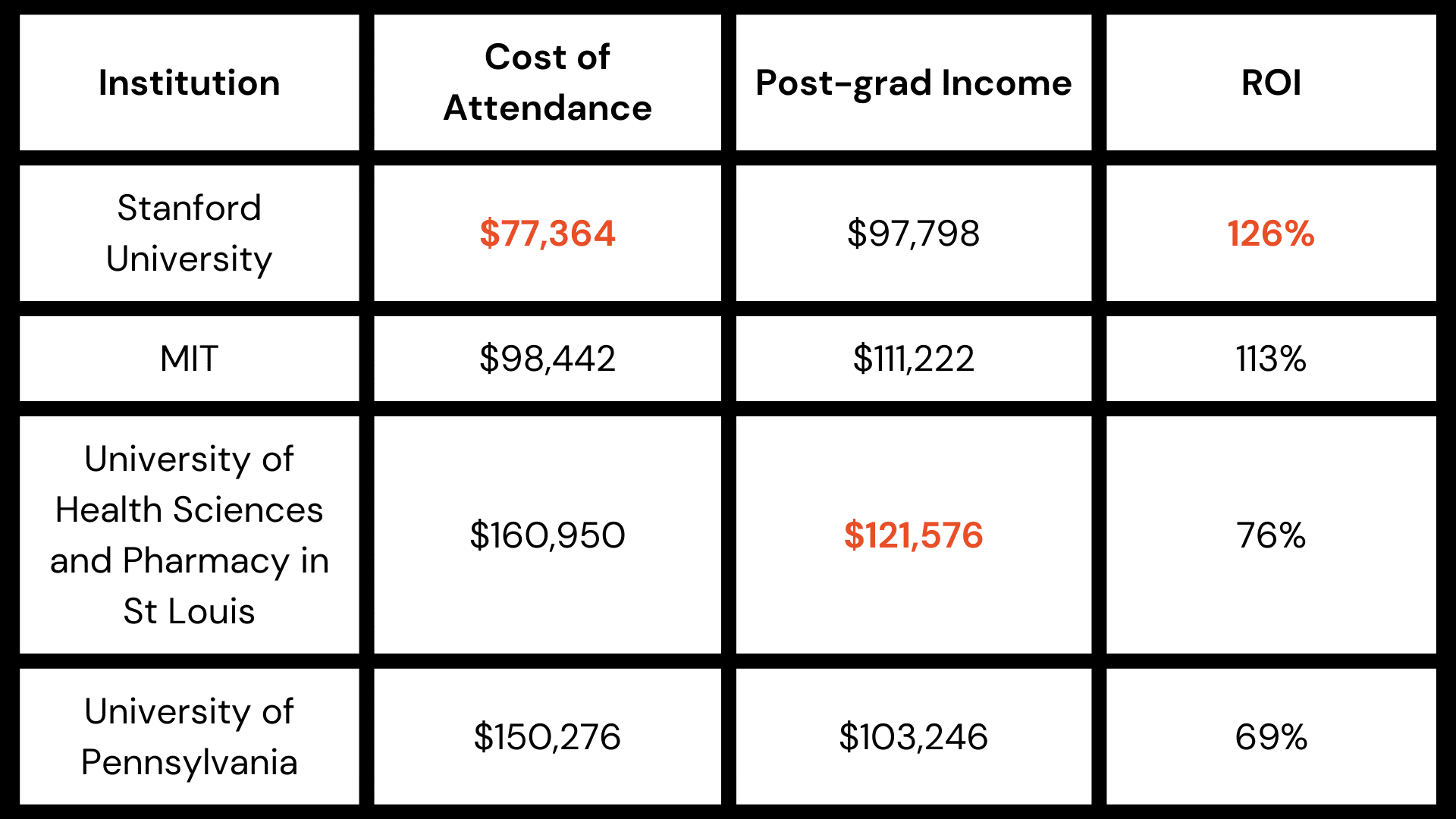
University of Pennsylvania Alternatives
- University of Pennsylvania programs
- Stanford University programs
- MIT programs
- University of Health Sciences and Pharmacy in St Louis programs
- Massachusetts Maritime Academy programs
- California State University Maritime Academy programs
- California Institute of Technology programs
The University of Pennsylvania, founded in 1740, offers majors and graduate degrees in architecture, business economics and public policy, urban spatial analytics, and more. The University of Pennsylvania’s cost-to-return ratio is 69%. Its non-Ivy alternatives include Stanford University, MIT, the University of Health Sciences and Pharmacy in St Louis, and four other institutions with comparable costs of attendance and post-grad incomes.
Cost of Attendance
- Stanford University – $77,364
- MIT – $98,442
- Massachusetts Maritime Academy – $126,786
- California State University Maritime Academy – $130,458
- University of Pennsylvania – $150,276
- California Institute of Technology – $159,252
- University of Health Sciences and Pharmacy in St Louis – $160,950
Post-grad Income
- University of Health Sciences and Pharmacy in St Louis – $121,576
- California Institute of Technology – $112,166
- MIT – $111,222
- University of Pennsylvania – $103,246
- Stanford University – $97,798
- Massachusetts Maritime Academy – $91,668
- California State University Maritime Academy – $91,461
ROI
- Stanford University – 126%
- MIT – 113%
- University of Health Sciences and Pharmacy in St Louis – 76%
- Massachusetts Maritime Academy – 72%
- California State University Maritime Academy – 70%
- California Institute of Technology – 70%
- University of Pennsylvania – 69%
#5 Columbia University in the City of New York
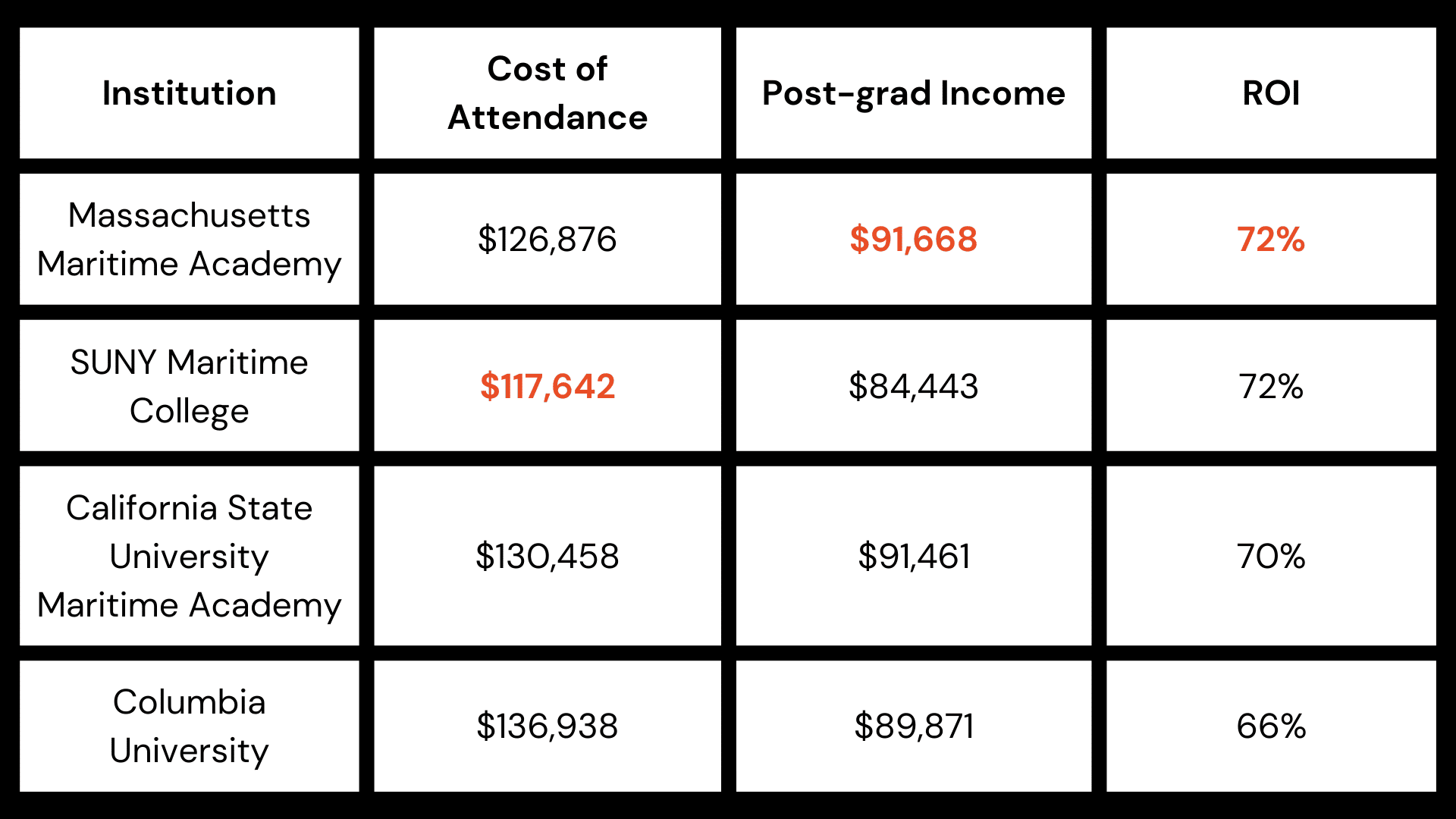
Columbia University Alternatives
- Columbia University in the City of New York programs
- Massachusetts Maritime Academy programs
- SUNY Maritime College programs
- California State University Maritime Academy programs
- St Paul’s School of Nursing-Queens programs
- Colorado School of Mines programs
Founded in 1754, Columbia University in the City of New York offers undergraduate and graduate programs in biophysics, theatre, sociomedical sciences, and much more. Its overall return on investment percentage is 66%. Below we’ve compiled five comparable non-Ivy alternative institutions with similar costs of attendance and post-grad incomes.
Cost of Attendance
- SUNY Maritime College – $117,642
- Massachusetts Maritime Academy – $126,876
- California State University Maritime Academy – $130,458
- Columbia University in the City of New York – $136,938
- St Paul’s School of Nursing-Queens – $146,850
- Colorado School of Mines – $162,684
Post-grad Income
- Massachusetts Maritime Academy – $91,668
- California State University Maritime Academy – $91,461
- Colorado School of Mines – $90,060
- Columbia University in the City of New York – $89,871
- St Paul’s School of Nursing-Queens – $87,418
- SUNY Maritime College – $84,443
ROI
- Massachusetts Maritime Academy – 72%
- SUNY Maritime College – 72%
- California State University Maritime Academy – 70%
- Columbia University in the City of New York – 66%
- St Paul’s School of Nursing-Queens – 60%
- Colorado School of Mines – 55%
#6 Dartmouth College
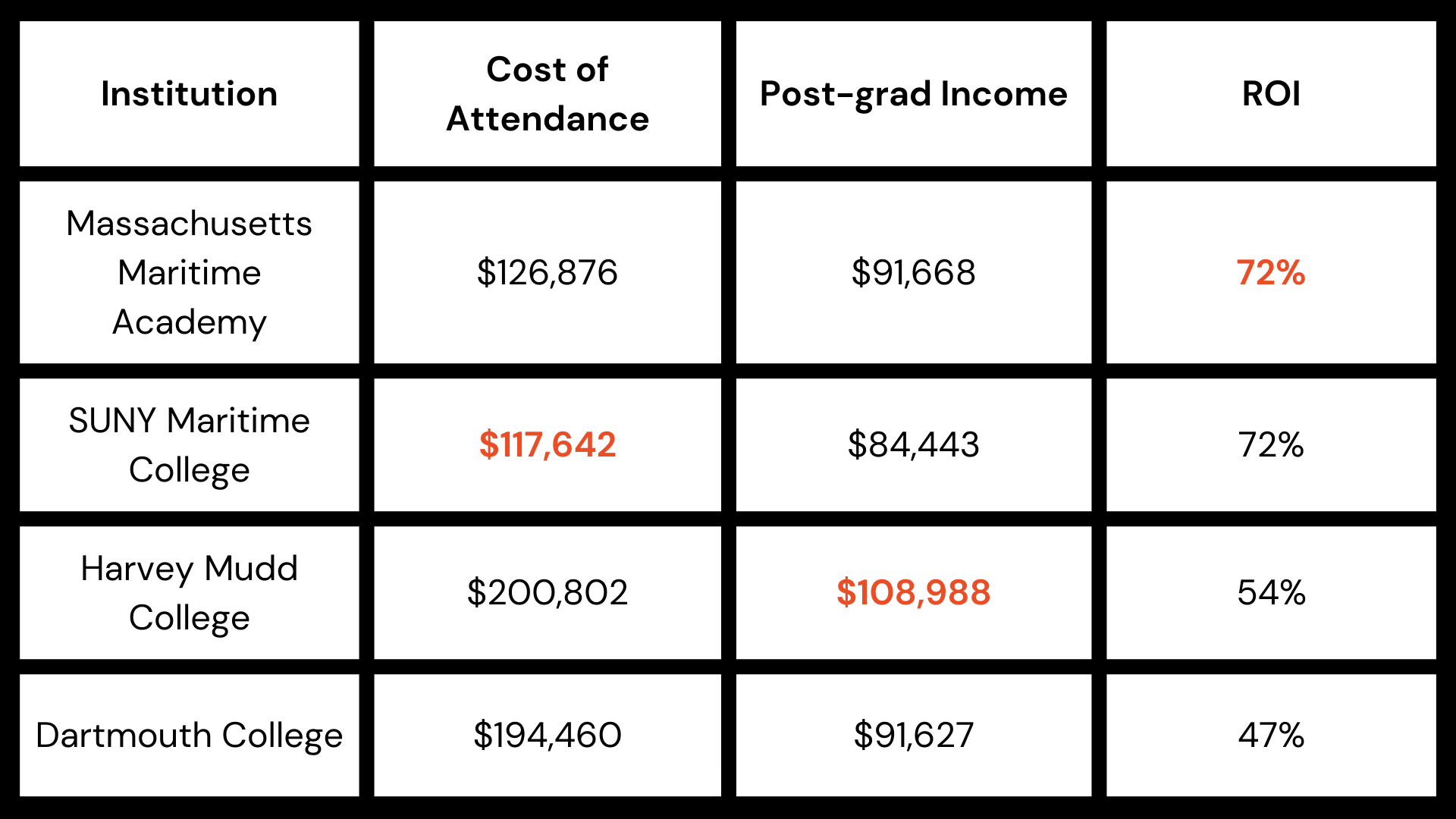
Dartmouth College Alternatives
- Dartmouth College programs
- SUNY Maritime College programs
- California Institute of Technology programs
- Harvey Mudd College programs
- Saint Joseph’s University programs
- Georgetown University programs
- Duke University programs
- Lehigh University programs
- Rensselaer Polytechnic Institute programs
Since founding in 1769, Dartmouth College has offered degrees in fields like physical and life sciences, engineering, humanities, and more. Dartmouth scores an overall ROI of 47%, and with nine comparable schools, it has the longest list of alternatives on our ranking.
Cost of Attendance
- SUNY Maritime College – $117,642
- Massachusetts Maritime Academy – $126,876
- California State University Maritime Academy – $130,458
- Saint Joseph’s University – $186,828
- Georgetown University – $192,648
- Dartmouth College – $194,460
- Duke University – $194,754
- Harvey Mudd College – $200,802
- Rensselaer Polytechnic Institute – $203,622
- Lehigh University – $206,304
Post-grad Income
- Harvey Mudd College – $108,988
- Saint Joseph’s University – $98,779
- Georgetown University – $96,375
- Lehigh University – $95,033
- Rensselaer Polytechnic Institute – $93,416
- Duke University – $93,115
- Massachusetts Maritime Academy – $91,668
- Dartmouth College – $91,627
- California State University Maritime Academy – $91,461
- SUNY Maritime College – $84,443
ROI
- Massachusetts Maritime Academy – 72%
- SUNY Maritime College – 72%
- California State University Maritime Academy – 70%
- Harvey Mudd College – 54%
- Saint Joseph’s University – 53%
- Georgetown University – 50%
- Duke University – 48%
- Dartmouth College – 47%
- Lehigh University – 46%
- Rensselaer Polytechnic Institute – 46%
#7 Brown University
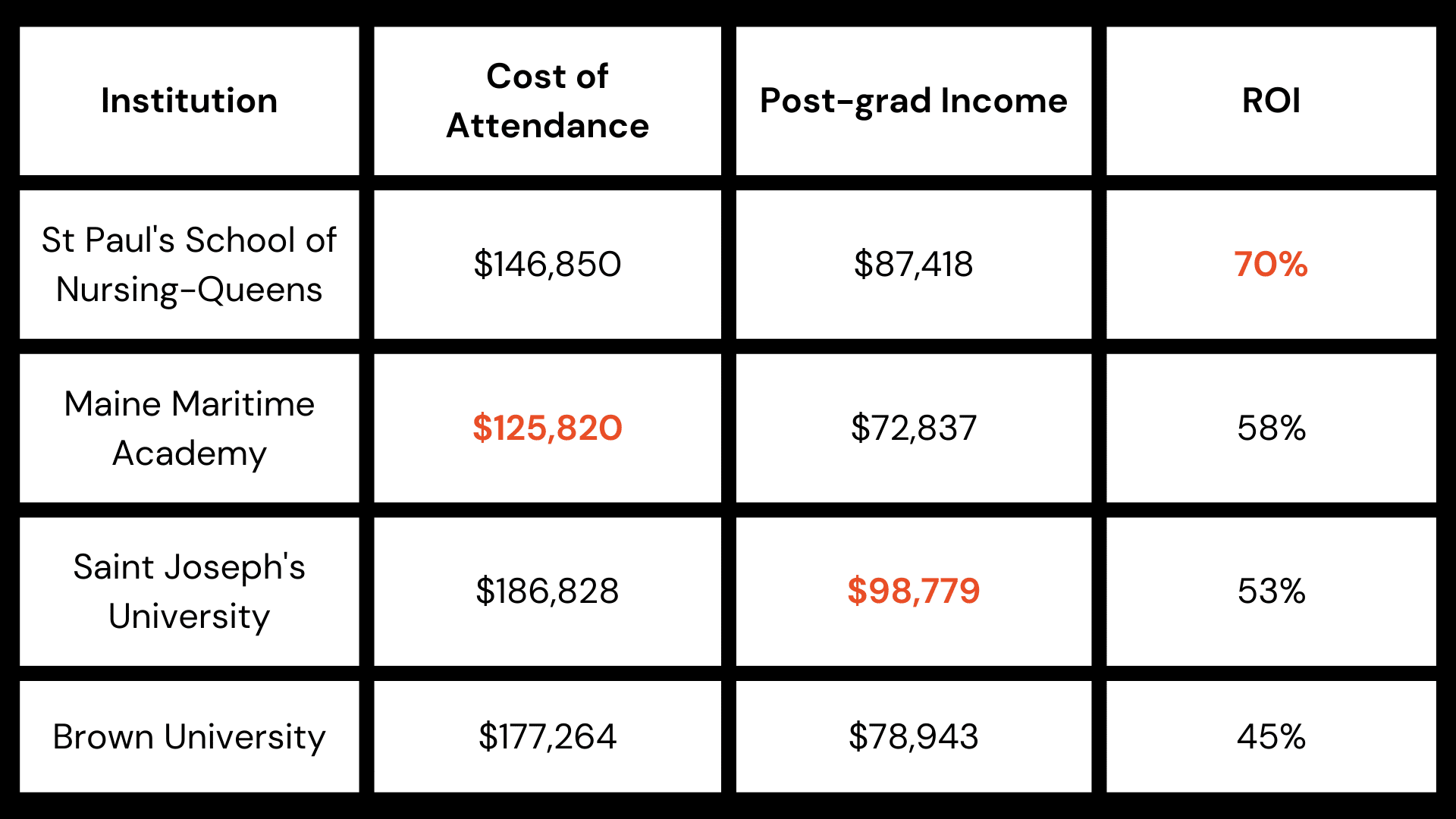
Brown University Alternatives
- Brown University programs
- St Paul’s School of Nursing-Queens programs
- Maine Maritime Academy programs
- Colorado School of Mines programs
- Saint Joseph’s University programs
Brown University was founded in 1764. It offers degrees in fields like anthropology, cognitive neuroscience, international relations, and more. The return-on-investment ratio at Brown is 45%. Its four non-Ivy alternative schools are comparable in terms of cost of attendance, post-grad income, and return on investment.
Cost of Attendance
- Maine Maritime Academy – $125,820
- St Paul’s School of Nursing-Queens – $146,850
- Colorado School of Mines – $162,684
- Brown University – $177,264
- Saint Joseph’s University – $186,828
Post-grad Income
- Saint Joseph’s University – $98,779
- Colorado School of Mines – $90,060
- St Paul’s School of Nursing-Queens – $87,418
- Brown University – $78,943
- Maine Maritime Academy – $72,837
ROI
- St Paul’s School of Nursing-Queens – 60%
- Maine Maritime Academy – 58%
- Colorado School of Mines – 55%
- Saint Joseph’s University – 53%
- Brown University – 45%
#8 Cornell University
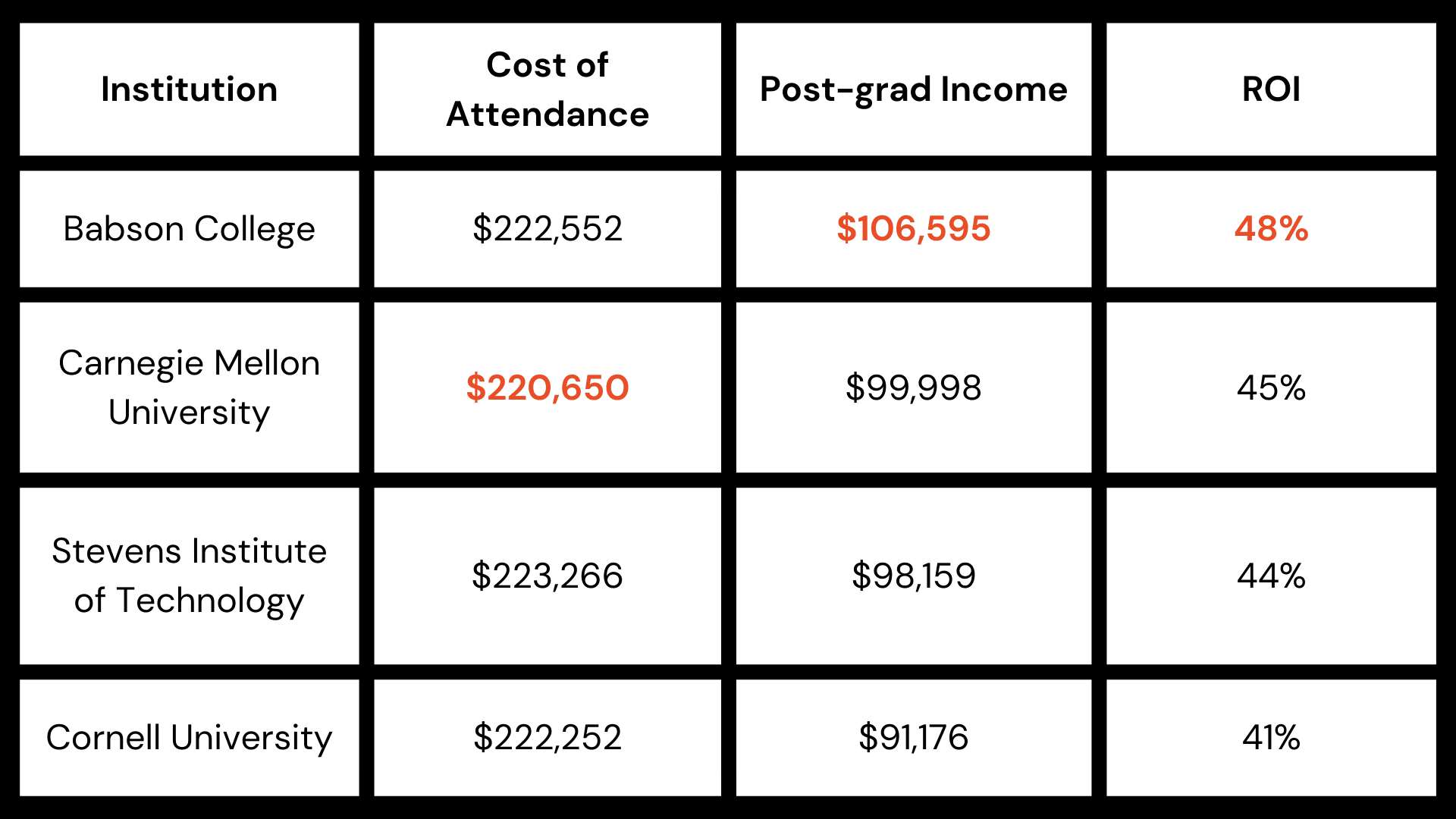
Cornell University Alternatives
- Cornell University programs
- Babson College programs
- Carnegie Mellon University programs
- Stevens Institute of Technology programs
- DigiPen Institute of Technology programs
Since its founding in 1865, Cornell University’s mission has been to “discover, preserve, and disseminate knowledge.” The school pursues this goal by offering degree programs in cognitive science, information science, psychology, and many others. Cornell’s return on investment score is 41%, and its four alternative options have similar ROIs, costs of attendance, and post-grad incomes.
Cost of Attendance
- Carnegie Mellon University – $220,650
- Cornell University – $222,252
- Babson College – $222,552
- Stevens Institute of Technology – $223,266
- DigiPen Institute of Technology – $241,302
Post-grad Income
- Babson College – $106,595
- Carnegie Mellon University – $99,998
- Stevens Institute of Technology – $98,159
- Cornell University – $91,176
- DigiPen Institute of Technology – $89,916
ROI
- Babson College – 48%
- Carnegie Mellon University – 45%
- Stevens Institute of Technology – 44%
- Cornell University – 41%
- DigiPen Institute of Technology – 37%
Unique Mentions
In our search for schools comparable to Ivy Leagues, we found several institutions with unique features. For example, maritime colleges prepare students for careers on sea vessels or in the seafaring industry and are often connected to a military branch. Colleges of pharmacy or health science offer career programs in the medical field. These colleges are limited in degree offerings, but for those interested in health or maritime careers, they’re worth exploring.
| School | Cost of Attendance | Post-grad Income |
| US Merchant Marine Academy | $39,426 | $83,209 |
| University of Health Sciences and Pharmacy in St Louis | $160,950 | $121,576 |
| Massachusetts Maritime Academy | $126,876 | $91,668 |
| SUNY Maritime College | $117,642 | $84,443 |
| California State University Maritime Academy | $130,458 | $91,461 |
| Albany College of Pharmacy and Health Sciences | $178,794 | $119,112 |
| St Paul’s School of Nursing-Queens | $146,850 | $87,418 |
| Maine Maritime Academy | $125,820 | $72,837 |
Conclusion
Whether you’re bound for the Ivies or ready to take on undergraduate life at a state college or university, the benefits of higher education are significant. Recent studies show that college graduates are half as likely to suffer unemployment than high school graduates with no post-secondary education. So whatever direction you decide to take with your college experience, Ivy Leagues or otherwise, your future will be bright.
Methodology
In our research for each school, we placed parameters on median 10-year post-graduation income, net price, and earnings-to-price return (or return on investment). We calculated the total cost of attendance by multiplying the annual net price by the national average of 6 years it takes to obtain a bachelor’s undergraduate degree. To calculate ROI percentages, we divided 10-year post-graduation income by the total cost of attendance and multiplied by 100 to obtain the ROI percentage.
All Ivy League Comparable Institutions
| Institution | Total Cost of Attendance | Post-grad Income |
| United States Merchant Marine Academy | $39,426 | $83,209 |
| Stanford University | $77,364 | $97,798 |
| Massachusetts Institute of Technology | $98,442 | $111,222 |
| Georgia Institute of Technology-Main Campus | $89,844 | $88,196 |
| University of Health Sciences and Pharmacy in St Louis | $160,950 | $121,576 |
| Massachusetts Maritime Academy | $126,876 | $91,668 |
| SUNY Maritime College | $117,642 | $84,443 |
| California Institute of Technology | $159,252 | $112,166 |
| California State University Maritime Academy | $130,458 | $91,461 |
| Albany College of Pharmacy and Health Sciences | $178,794 | $119,112 |
| St Paul’s School of Nursing-Queens | $146,850 | $87,418 |
| Maine Maritime Academy | $125,820 | $72,837 |
| Colorado School of Mines | $162,684 | $90,060 |
| Harvey Mudd College | $200,802 | $108,988 |
| Saint Joseph’s University | $186,828 | $98,779 |
| Georgetown University | $192,648 | $96,375 |
| Babson College | $222,552 | $106,595 |
| Duke University | $194,754 | $93,115 |
| Lehigh University | $206,304 | $95,033 |
| Rensselaer Polytechnic Institute | $203,622 | $93,416 |
| Carnegie Mellon University | $220,650 | $99,998 |
| Stevens Institute of Technology | $223,266 | $98,159 |
| Bentley University | $248,004 | $107,974 |
| Rose-Hulman Institute of Technology | $233,850 | $94,131 |
| DigiPen Institute of Technology | $241,302 | $89,916 |





